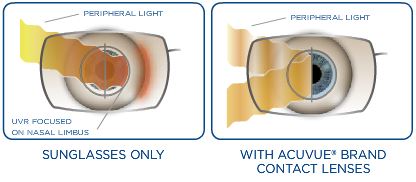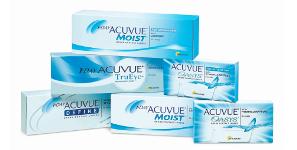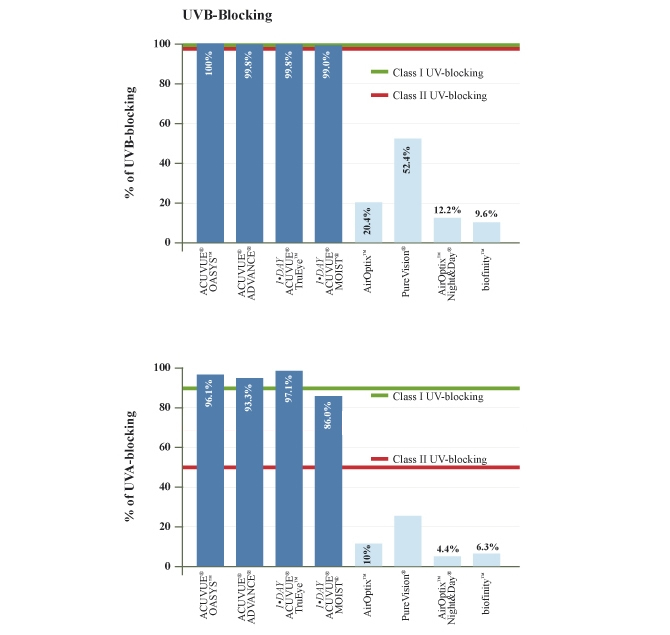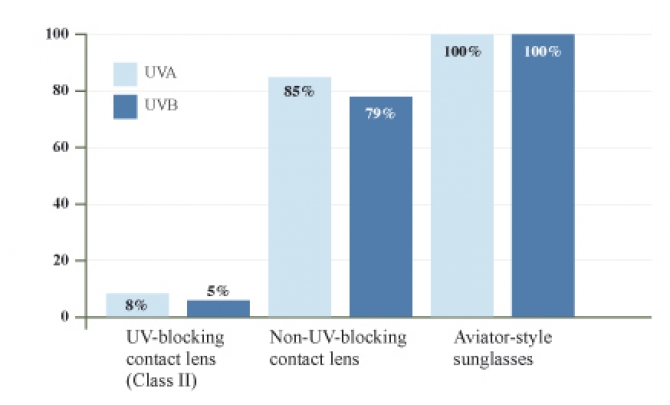Overview
Even if your patients are 100% compliant when it comes to wearing their sunglasses outdoors, they may not be getting optimal eye protection that is required throughout the year. While many standard sunglasses offer some level of UV-blocking, rays can enter from the side to reach the eye with non wrap-around styles.
UV-blocking contact lenses
Well-fitting soft contact lenses cover the entire cornea and limbus. Adding a UV-blocker into a soft lens helps to protect both this area and the interior of the eye from the transmission of direct and reflected UV rays. Unlike some standard sunglasses, they are also effective at protecting from the Peripheral Light-Focussing (PLF) Effect.
All ACUVUE® contact lenses offer UV-blocking
 |
ACUVUE® contact lenses are the only major brand which blocks more than 98% UVB and 85% UVA rays as standard across the range.* |
Contact lens patients see the value in UV-blocking contact lenses
Research shows that 65% of patients are concerned about protecting their eyes from UV rays and 55% would pay more for contact lenses with protection from UV exposure.2
85% of teen/pre-teen parents involved in a study said protection from UV exposure is important or very important when deciding which contact lenses their children should wear.4
* All ACUVUE® brand contact lenses have Class 1 or Class 2 UV-blocking to help provide protection against transmission of harmful UV radiation to the cornea and into the eye. UV-absorbing contact lenses are NOT substitutes for protective UV-absorbing eyewear such as UV-absorbing goggles or sunglasses because they do not completely cover the eye and surrounding area. UV transmission measured with -1.00D lens. JJVC Data on file 2012.
1. Sulley A, Sencer S, Ruston D & R Packe. UV - What your patients don't know. Optom Vis Sci 2012 E-abstract 1255448.
2. Contact lenses in paediatrics study (J Walline et al). Data on file 2007.
ACUVUE® contact lenses
ACUVUE® contact lenses are the only major brand which blocks more than 98% UVB and 85% UVA rays as standard across the range.*

| Class 1 UV-blocking | Class 2 UV-blocking | |
| 1-DAY ACUVUE® TruEye® | 1-DAY ACUVUE® MOIST | |
| ACUVUE OASYS® | 1-DAY ACUVUE® MOIST for ASTIGMATISM | |
| ACUVUE® ADVANCE | ||
| ACUVUE OASYS® for ASTIGMATISM | ||
| ACUVUE® ADVANCE® for ASTIGMATISM | ||
| ACUVUE OASYS® for PRESBYOPIA | ||
|
Class 1 UV-blocking provides >99% UVB and >90% UVA.* |
Class 2 UV-blocking provides >95% UVB rays and >50% UVA. * |
Comparing UV-blocking

*All ACUVUE® brand contact lenses have Class 1 or Class 2 UV-blocking to help provide protection against transmission of harmful UV radiation to the cornea and into the eye. UV-absorbing contact lenses are NOT substitutes for protective UV-absorbing eyewear such as UV-absorbing goggles or sunglasses because they do not completely cover the eye and surrounding area. UV transmission measured with -1.00D lens. JJVC Data on file 2012.
UV-blocking
Many standard sunglasses offer some level of protection from UV exposure, but the amount of coverage may not always be complete.1
Standard non wrap-around sunglass frame styles do not prevent damaging UV rays from reaching the eyes because direct and reflected light can enter from the sides, top and bottom of the frames. Corneal optics focus and intensify UV rays entering from the side onto the nasal lens and limbus – an effect defined as the Peripheral Light-Focussing (PLF) Effect.2 These peripheral rays may actually be more harmful than those entering directly from the front.
The intensity of light that gets past most sunglasses is 22 times stronger at the nasal limbus and eight times stronger at the nasal lens cortex, the most common locations for pterygium and cortical cataract.
UV-blocking with contact lenses

As shown in this graph, a pair of aviator-style sunglasses and non-UV-blocking contact lenses block very little UV compared to UV-blocking contact lenses.
UV-blocking contact lenses help to provide extra ocular protection from the transmission of UV rays by filling in some of the gaps left by traditional measures.3,4
- Because UV-blocking contact lenses cover the entire cornea and limbus, they are effective in blocking the transmission of light rays reflected up from surfaces and peripheral rays that enter from the side. UV-blocking contact lenses help to protect against transmission of UVR to the cornea and into the eye
- UV-blocking contact lenses help to protect from the transmission of UV rays throughout the day without the wearer having to think about using them *
Research into UV-blocking effect of contact lenses
An anatomically correct eye model was equipped with UVA and UVB sensors at the nasal limbus and was exposed to sunlight in three outdoor environments: urban, mountain and beach. The intensity of UVA radiation at the nasal limbus is similar in all three environments without sunglasses, with sunglasses or with non-UV-blocking contact lenses. In contrast, only the UV-blocking contact lenses achieved a significant blocking effect on UVR in all three environments.
* All ACUVUE® brand contact lenses have Class 1 or Class 2 UV-blocking to help provide protection against transmission of harmful UV radiation to the cornea and into the eye. UV-absorbing contact lenses are NOT substitutes for protective UV- absorbing eyewear such as UV-absorbing goggles or sunglasses because they do not completely cover the eye and surrounding area.
1. Sliney DH. Photoprotection of the eye — UV radiation and sunglasses. J Photochem Photobiol B. 2001;64:66–75.
2. Kwok LS, Daszynski DC, Kuznetsov VA, Pham T, Ho A, Coroneo MT. Peripheral light-focussing as a potential mechanism for phakic dysphotopsia and lens phototoxicity. Ophthalmic Physiol Opt 2004;24(2):119-29.
3. Chandler H. UV absorption by contact lenses and the significance on the ocular anterior segment. Eye & Contact Lens 2011;37:4 259-266.
4. Chalam KV, Khetpal V, Rusovici R et al. A review: role of ultraviolet radiation in age-related macular degeneration. Eye & Contact Lens 2011;37:4 225-232.


